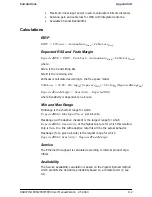
About the Fresnel Zone
Appendix D
RADWIN 1000/2000/5000 User ManualVersion 2.5.30p3
D-13
About the Fresnel Zone
The Fresnel zone (pronounced "frA-nel", with a silent “s”) is an elliptically
shaped conical zone of electromagnetic energy that propagates from the
transmitting antenna to the receiving antenna. It is always widest in the
middle of the path between the two antennas.
Figure D-9: Fresnel zone
Fresnel loss is the path loss occurring from multi-path reflections from
reflective surfaces such as water, and intervening obstacles such as build-
ings or mountain peaks within the Fresnel zone.
Radio links should be designed to accommodate obstructions and atmo-
spheric conditions, weather conditions, large bodies of water, and other
reflectors and absorbers of electromagnetic energy.
The Fresnel zone provides us with a way to calculate the amount of clear-
ance that a wireless wave needs from an obstacle to ensure that the obsta-
cle does not attenuate the signal.
There are infinitely many Fresnel zones located coaxially around the center
of the direct wave. The outer boundary of the first Fresnel zone is defined
as the combined path length of all paths, which are half wavelength (1/2
)
of the frequency transmitted longer than the direct path. If the total path
distance is one wavelength (1
) longer than the direct path, then the outer
boundary is said to be two Fresnel zones. Odd number Fresnel zones rein-
force the direct wave path signal; even number Fresnel zones cancel the
direct wave path signal.
















































